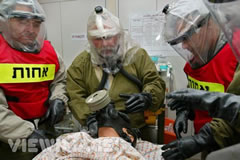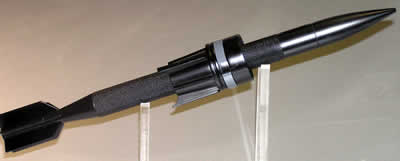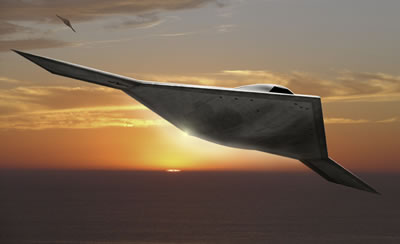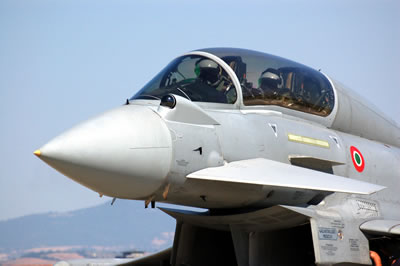It will probably become the largest arms deal in the history of the volatile Middle East: Advanced US weapons systems worth a total of about $40 billion will be sold over the next 15 years to America’s allies in the region. Washington’s main objective seems to create a strategic military balance vis-à-vis the rise of Russia’s supported Iran, while curbing the erosion in the Bush administration’s regional standing – which may escalate further following a withdrawal from Iraq, in a down-scaling military presence process, inflaming an already highly tension-filled region.
In a situation, which brings back memories of a long-gone superpower “Cold War” conflict era, Moscow is also ready to sign its largest arms deal in 30 years, promising to deliver billion dollars worth in warplanes, refueling tankers and sophisticated military hardware to its clients in Iran and Syria. The deal, offered to Tehran’s Islamic fundamentalist cleric regime includes no less than 250 Sukhoi Su-30 long-range strike fighters, having maximum range of 3,000 km, but Tehran also wishes to augment the purchase by adding refueling tankers that will increase the jet fighter’s range to 8,000 km. The Russians churned out the Sukhoi SU-30 to compete with the first class USAF Boeing F-15E long range, heavy payload/ multi-role fighter jet.
Meanwhile, Moscow’s respected business daily Kommersant reported that Russia’s arms trading monopoly Rosoboronexport has begun to fulfill an arms deal which was secretly signed with Syria earlier this year to selling five MiG-31E (Foxhound) jet fighters, considered one of the best in the world, with an additionally unspecified number of the newest Russian MiG-29M/M2 fighters.
These purchases should substantially enhance the Syrian and Iranian air force capabilities against Israel, the US and coalition air forces, in a future conflict situation. According to intelligence assessments, the arms deal could signify a Russian response to the US decision to sell thousands of Joint Direct Attack Munition (JDAM) units to Saudi Arabia, a technology that upgrades free-fall bombs into guided smart bombs, which could be used in potentially deterrent air strikes against Iranian nuclear project targets.
The crucial question asked by analysts is why both Moscow and Washington have chosen the present time for such earth-shaking, high-profile hand-outs to their respective clientele in this region. Is the bilateral tension, fueled recently by the Bush and Putin over the planned forward deployed missile defenses, actually getting out of control and emerging into a repeat performance of a mutual arms race- Cold War style? Are there even more sinister, political and strategic considerations at stake here? Or could it be, that Moscow has a strategic interest to support a Shi’ite axis, in order to enhance its presence in the oil rich region, to counter the currently forming Sunni pact, under Washington’s sponsorship? Only time will tell, as this strange turn of events is shaping into a new strategic reality. One thing is certain, neither of these answers are boding well for this highly explosive region, with its military hardware arsenals already filled to the brim with the latest destructive weapon systems, that petro-dollars can buy.
But there might well be a much more simplistic reason behind this unfolding weapons Bonaza! The one to raise this in a tongue-in-cheek announcement last week was none other than Iran’s own Defense Minister Mostapha Mohammad Najjar who frankly said that the US is waging an arms race in the region to prevent its “big arms companies from going bankrupt”! Moreover, the minister openly admitted, that Iran is not worried by “Muslim, friendly and brother” countries’ efforts to strengthen their defensive capabilities,” adding that a boost in their defensive power is bolstering the defensive capabilities of the Islamic world. There can be no clearer statement to emphasize the sheer stupidity of such an irresponsible move by two shortsighted world leaders, recklessly inflaming this volatile powder keg with more destructive war machines.
However there are other issues, no less crucial and equally dangerous to this region, which must be considered under the present trend. There has been a surprising diplomatic flurry from Saudi Arabia since early this year, when the aftermath of Israel’s war against the Tehran-backed Hezbollah, served as a wake-up call. The so-called “Shi’ite Crescent”, is currently challenging Muslim-Sunni domination of the Middle East, traditionally led by Saudi Arabia. The result was that Rhiyad emerged as high-profile sponsor of an inter-Palestinian dispute, between Hamas (supported by Iran) and Fatah, which desperately seek recognition by the “moderate” Arab world, sofar without avail. The other issue which worried the Saudi Kingdom was the fate of Lebanon, which seemed, earlier this year on the verge of falling into the trap set by the shrewd President Mahmoud Ahmadinejad’s Shi’ite expansionist ambitions. Saudi King Abdulla bluntly told the Iranian president, on his visit yo Rhiyad, to “stop meddling in Lebanon’s political affairs” this being Saudi Arabia’s domain. Rhiyad also sponsored the, alas, shortlived unification between Abu Mazen and Ismail Haniyeh’s rival factions, which unfortunately escalated into Hamastan in the chaotic Gaza Strip enclave.
Washington’s latest, perhaps last attempt to solve the insoluble Israel-Palestinian conflict started this week, with US Foreign Secretary Condoleezza Rice’s visit to the region, preparing the Bush initiated Arab-Israeli summit, upon which the already hard-pressed US President is placing high, but quite unrealistic hopes.
In fact, any attempts by Washington to present Saudi Arabia as a moderate Arab nation backing the moderate Abbas regime in Ramallah and placing this highly complex issue into an inter-Arab context, are misleading. Saudi Foreign Minister Prince Saud al-Faisal said clearly that a precondition of its attendance was that the conference tackles the four big “final status” issues that had bedeviled peace negotiators since 1979. However, he stressed, “We are interested in the peace conference, one that deals with the heart of the peace process, the issues of peace, the core issues, not one that is just a podium for meetings and talk that do not enrich peace.” Without guarantees that the conference will address these issues, therefore, Saudi delegates are most unlikely to attend. In fact, as the United States looks to regional actors for support on Iraq, Iran and Israeli-Palestinian issues, it will find that Riyadh is not going to play its assigned role. While President George W. Bush’s administration faces long odds on these issues already, the Saudi position makes the prospect for success even less likely. Perhaps Mr Bush’s hopes gaining Riyadh’s goodwill by his “friendly” arms package?
Israel’s foreign minister, Tzipi Livni said on Wednesday during meetings with the US Secretary, who flew to Jerusalem after talks with the Saudis in Jedda, that while Israel welcomed the latest Saudi comments, their precondition may not be so easy to meet. A clear understatement, perhaps diplomatically set so, to meet the circumstances prevailing in Jerusalem on the visit.
Under the intricate circumstances that have existed in past attempts to try and break the deadlock in the political impasse between Israel and its Palestinian neighbors, all efforts failed, when preconditions were set by any of the Arab parties, which Israel could not accept without committing political, if not sheer strategic suicide. A major stumbling block to any possible constructive dialogue would be the continued exclusion of Damascus, into any negotiation process. Without Syria, or even Hamas being involved, there will be no substance to any decisions reached in the forthcoming summit, nor can neither Olmert nor Abbas by themselves implement any decisive moves. Olmert has neither public, nor political backing for a major dramatic step, while Abbas merely represents a minor part of the Palestinian people, even in the West bank, not to mention the Gaza Strip’s one and half million people of his Palestine. Even thinking about a Palestinian state under such conditions is only wishful thinking, if not a waste of time. Syria is the key to any future peace agreement with Israel and as long as it remains isolated there will be no relaxing of the tension in the north, with either Hezbollah or Syria and Iran’s dangerous meddling in Lebanese affairs.
President Bush’s present aspirations will backfire, just as his vision for a democratic Middle East has already taught Washington the stark realities of the Orient. The only way that any substantial effort might eventually pay off, is through a new situation in which dominant leaders, calibers like Ariel Sharon, Yizhak Rabin in Israel, and charismatic statesmen in Palestine, will negotiate directly face-to-face, without outsiders trying to mediate, by involving their own interests. Sofar any such leaders are unfortunately not in sight on either side.
But what is most worrying to the regional leaders is the real reason behind George Bush’s latest gesture and, more important, what strings are attached on Washington’s magnanimous gift package?
In yesterday’s news a minor report was filed by the U.S. 5th Fleet’s headquarters in Bahrain confirming that the USS John C. Stennis and the USS Nimitz carrier groups were returning to their home ports of Bremerton, Washington, and San Diego, California while the USS Eisenhower entered the area. This indicates that the Navy is scaling down its Gulf presence, for at least three months, until USS Harry S. Truman is deployed in the fall. Is this a first indication that Washington intends to leave the region to fend for itself against a future Nuclear Iran, by filling the local arsenals with high profile weapons and then get out from this self-made quagmire, as Bush’s predecessors did decades ago from Vietnam?
But such a massive arms deal with even “moderate” Arab nations has its inherent danger, which cannot be overlooked. A radical Islam is already threatening to undermine the stability of secular Arab regimes and the real danger of radicals taking over sophisticated weapons systems is more than realistic. It happened already in Iran and Hamastan and could also happen in Saudi Arabia or even Egypt.
Former Israeli ambassador to the UN Dore Gold and an expert on Mid Eastern affairs mentioned that al Qaeda has already penetrated different branches of Saudi Armed forces. Attempts by Saudi security forces to quell al-Qaeda in the Kingdom, have only been partial and the threat exists. In Fact, large parts of Saudi Arabia have become a hot house for radical Sunni Islam.
According to Dr Gold:. “The current radical Islamic wave that Western alliance is facing has two sources. First, the Islamic revolution in Iran led by Ayatollah Khamenei. And the second is the rise of al-Qaeda in Afghanistan, much of which is backed by Saudi Arabia. Therefore an effective counter-strategy has to take into account both sources of the problem,” Dr Gold said, “when it comes to Saudi Arabia, the Israeli government suffers from a certain myopia, forgetting that in the 9/11 attacks, 15 of the 19 terrorists were Saudis, and that up until recently, Saudi Arabia was the primary founder of Hamas during the high point of the suicide bombing attacks against Israel ” Dr. Gold added.
No doubt the present arms race will continue in this most volatile region in the world, with Moscow’s Putin providing highly lethal weapons to the reckless leader who supports al Qaeda, Hezbollah, and Hamas, and who has made his plans for holy war, not only public knowledge, but a messianic ambition.



 In fact, Israeli counter-terror sources and even DebkaFile’s monitors have already said that there is no way of gauging for sure how serious these threats are, how real, or whether they are not part of a war of nerves to give the Gaddahn tape “extra mileage”. But, sources indicate, it should be important to note that the exchange of messages took place over al Qaeda’s internal Internet sites which contained the threat of radioactive terror, pointing to specific American cities for the first time, after a long silence on such subjects.
In fact, Israeli counter-terror sources and even DebkaFile’s monitors have already said that there is no way of gauging for sure how serious these threats are, how real, or whether they are not part of a war of nerves to give the Gaddahn tape “extra mileage”. But, sources indicate, it should be important to note that the exchange of messages took place over al Qaeda’s internal Internet sites which contained the threat of radioactive terror, pointing to specific American cities for the first time, after a long silence on such subjects. Nevertheless, Israel may already be preparing at last to face the threat of this kind of unconventional warfare. In a recent nationwide large-scale civil defense drill, anti-terrorist security forces featured a response to a mock chemical terror strike at a school in Ramat Gan. The scenario envisioned a group of terrorists breaking into the school and attacking with a chemical that caused symptoms such as sweating and breathing difficulty. Officials mentioned this being the first of following drills by the Home Front Command.
Nevertheless, Israel may already be preparing at last to face the threat of this kind of unconventional warfare. In a recent nationwide large-scale civil defense drill, anti-terrorist security forces featured a response to a mock chemical terror strike at a school in Ramat Gan. The scenario envisioned a group of terrorists breaking into the school and attacking with a chemical that caused symptoms such as sweating and breathing difficulty. Officials mentioned this being the first of following drills by the Home Front Command.





 The US Navy UCAS program was born from the former Joint Unmanned Combat Air Systems (J-UCAS) program sponsored by DARPA. For this program Boeing developed the X-45 while Northrop Grumman developed the X-47 UCAV demonstrators. The Navy’s UCAS is focusing on a strike-fighter sized unmanned air vehicle which will demonstrate carrier flight operations. Testing is scheduled to begin by mid 2010 and culminate with carrier flight operations in 2013. The tests will involve shipboard operation, including catapult takeoffs, arrested landings and flight in the immediate vicinity of an aircraft carrier. The air vehicle will not carry weapons.
The US Navy UCAS program was born from the former Joint Unmanned Combat Air Systems (J-UCAS) program sponsored by DARPA. For this program Boeing developed the X-45 while Northrop Grumman developed the X-47 UCAV demonstrators. The Navy’s UCAS is focusing on a strike-fighter sized unmanned air vehicle which will demonstrate carrier flight operations. Testing is scheduled to begin by mid 2010 and culminate with carrier flight operations in 2013. The tests will involve shipboard operation, including catapult takeoffs, arrested landings and flight in the immediate vicinity of an aircraft carrier. The air vehicle will not carry weapons.

 Thus, if this trend by Hezbollah’s leader remains, it would seem logic that General Aoun’s popularity is likely to vanish if he continues to stand behind Nasrallah, giving his Christian followers second thoughts over their strange alliance with Nasrallah’s Shi’ites. In fact, Aoun’s popularity within the Maronite Christian population is still high. This community will no doubt become the main target in any future confrontations with either Sunni extremist factions, or Hezbollah Thus, General Michel Aoun could well opt again for a new volte face to take the helm, saving the community from yet another tragedy. Analysts claim that without a consensus candidate in sight for the presidential election which is to be carried out in parliament, the sole declared runner could be the controversial Michel Aoun, who was exiled in Paris after the war with Syrian troops but returned when they finally withdrew in 2005.
Thus, if this trend by Hezbollah’s leader remains, it would seem logic that General Aoun’s popularity is likely to vanish if he continues to stand behind Nasrallah, giving his Christian followers second thoughts over their strange alliance with Nasrallah’s Shi’ites. In fact, Aoun’s popularity within the Maronite Christian population is still high. This community will no doubt become the main target in any future confrontations with either Sunni extremist factions, or Hezbollah Thus, General Michel Aoun could well opt again for a new volte face to take the helm, saving the community from yet another tragedy. Analysts claim that without a consensus candidate in sight for the presidential election which is to be carried out in parliament, the sole declared runner could be the controversial Michel Aoun, who was exiled in Paris after the war with Syrian troops but returned when they finally withdrew in 2005. Ahmadinejad also asked Tehran’s protégé Hassan Nasrallah to try and understand that his government was financially squeezed by its preparations for a future conflict and was therefore unable, at the moment, to remit the one million dollars promised to repair the war damage suffered by South Lebanon last year. This was apparently part of the Iranian leader’s discontent with Hezbollah failing him miserably, in disregarding Tehran’s specific instructions over the use of its medium-and long range missile arsenal – which was totally lost during the first days of the so-called “Tamuz” war last summer. According to reports, Nasrallah was visibly taken aback by his sofar loyal sponsor’s rigid stance. Nasrallah claimed that he too was weighed down by the heavy cost of his pledges to the inhabitants of southern Lebanon, from which he might lose support if their situation was not solved within foreseeable time but it seems that Ahmadinejad remained adamant.
Ahmadinejad also asked Tehran’s protégé Hassan Nasrallah to try and understand that his government was financially squeezed by its preparations for a future conflict and was therefore unable, at the moment, to remit the one million dollars promised to repair the war damage suffered by South Lebanon last year. This was apparently part of the Iranian leader’s discontent with Hezbollah failing him miserably, in disregarding Tehran’s specific instructions over the use of its medium-and long range missile arsenal – which was totally lost during the first days of the so-called “Tamuz” war last summer. According to reports, Nasrallah was visibly taken aback by his sofar loyal sponsor’s rigid stance. Nasrallah claimed that he too was weighed down by the heavy cost of his pledges to the inhabitants of southern Lebanon, from which he might lose support if their situation was not solved within foreseeable time but it seems that Ahmadinejad remained adamant. instructions. First signs in Iran are evident already, as shortly after raising gasoline prices by 25 percent, the government began fuel rationing, sparking violence in Tehran as angry Iranians smashed shop windows and set fire to a dozen gas stations.
instructions. First signs in Iran are evident already, as shortly after raising gasoline prices by 25 percent, the government began fuel rationing, sparking violence in Tehran as angry Iranians smashed shop windows and set fire to a dozen gas stations.











